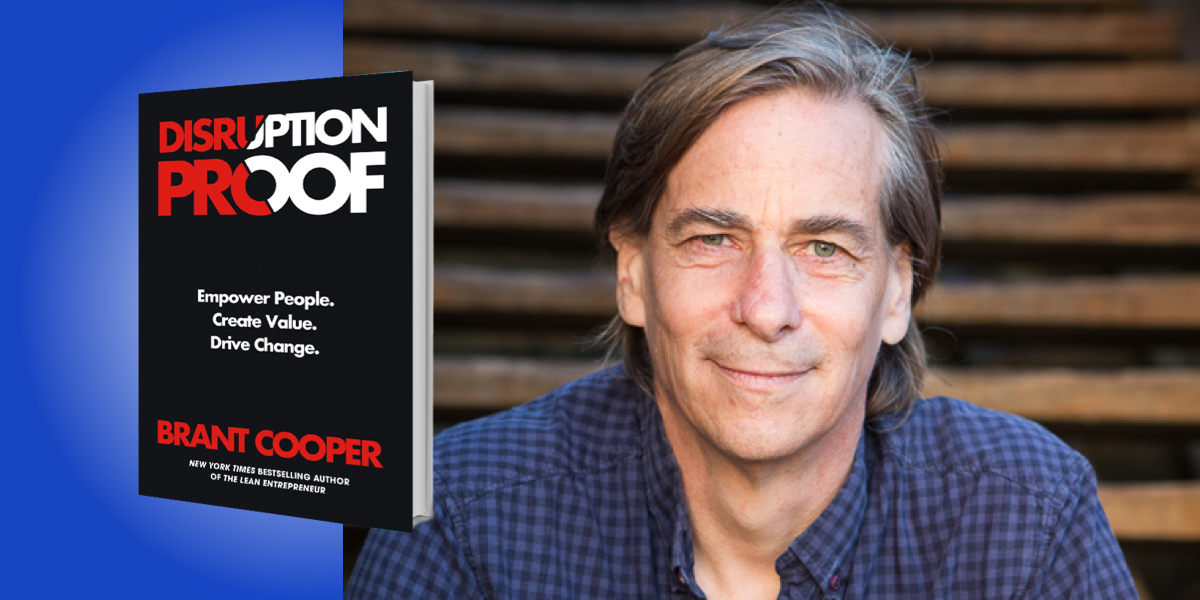Brant Cooper is the author of the New York Times bestseller The Lean Entrepreneur, and is a sought-after speaker, startup advisor, and mentor. He is the co-founder of Moves the Needle Group, which has advised such leading companies as Qualcomm, Intuit, Capital One, Pitney Bowes, and 7-11.
Below, Brant shares 5 key insights from his new book, Disruption Proof: Empower People, Create Value, Drive Change. Listen to the audio version—read by Brant himself—in the Next Big Idea App.
1. Most businesses do not need to disruptively innovate.
Technical innovation was a hallmark of the 20th century, generating never-before-seen products designed to improve people’s lives. These products involved a lot of technical risk and efficiency challenges: “Can we build a microwave oven? Can we build it efficiently enough that the middle class can afford it?” But these innovative products involved very little market risk. If the price was right, people would buy them. From the consumer perspective, there weren’t many choices.
But that isn’t today’s world. Today, customers have choices between multiple models of nearly every product, with multiple options. Through review sites, social media, and regulated transparency, customers have more information than ever helping them choose what to buy. In this environment, the primary risk to most businesses is not technical, but market. They know they can build a product, but should they? Can they successfully compete?
We’ll continue to see new products that improve lives based upon invention, especially in fields like healthcare, life sciences, blockchain, quantum computing, new materials design, and artificial intelligence. But the vast majority of businesses don’t need to invent technology. They need to better leverage existing technology and better serve their customers—to learn how to compete by creating value.
“The vast majority of businesses don’t need to invent technology. They need to better leverage existing technology and better serve their customers.”
2. The rise of the RAD mindset.
The 20th century was largely focused on operational efficiency. Think back to Henry Ford’s assembly line, for example, which was designed to maximize output, producing one model car in one color. The rest of the Ford Motor Company was essentially an extension of the assembly line. Departments were based on function—rigid, hierarchical, and as repetitive as possible. The object was to remove all variants and manage to financial efficiency.
Today’s economy is much more complex. We are massively interconnected. Information and disinformation move at the speed of light. This meshed network of communications and commerce means we are more susceptible to disruptions—not just technical or startup disruptions, but ships stuck in canals that interrupt global supply chains, ransomware attacks that bring down healthcare systems, collapsed energy grids, and of course, pandemics. The result of all of this is pervasive uncertainty. And yet, most institutions we depend on—business, government, education—are still managed in the old, hierarchical manner, as if we were still in the middle of the industrial age.
If companies are to compete on creating value, they must use a different operating system, which I called the RAD mindset: Resilient, Aware, and Dynamic. Organizations must be managed and structured to be resilient, able to weather the storms of endless disruptions by being redundant and flexible. They must be aware of the environment both internally and externally, locally and globally. And organizations must be dynamic, able to quickly change their plans and operations based on new information.
Companies exhibiting a RAD mindset were able to weather the COVID-19 pandemic better than others. Gerber Technologies, which produces software and hardware for the textile industry, faced jeopardy when their clients’ production facilities in China were shut down by the pandemic. But within a few weeks, Gerber had helped their clients pivot to manufacturing PPE, gowns, and face masks, producing much-needed equipment that benefited the world while saving their clients’ revenue—as well as their own.
“Most institutions we depend on—business, government, education—are still managed in the old, hierarchical manner, as if we were still in the middle of the industrial age.”
3. The five elements of creating a RAD mindset.
There are five E’s of a RAD mindset that must be spread all across a company, from the front line to the C-suite, from customer support to back-office functions like human resources and finance:
Empathy. This means understanding our customers deeply, understanding what drives them, what their needs and aspirations are. Empathy should be applied internally as well: understanding employees, colleagues, and leadership.
Exploration. This is admitting what we don’t know, and then seeking to learn. It means testing our assumptions and being willing to be wrong.
Evidence. We use data and insights to cut through our biases and inform our decision-making. We don’t want data to make decisions for us, but we certainly should use the output of our experiments and the insights that we glean from customers to help us create value.
Equilibrium. We have to find the right balance between execution and exploration, and we should strive to live a balanced life. The pandemic has brought home the fact that we all have a lot going on, and we need the time and space to manage those other parts of our lives that make us more fulfilled human beings. After all, we know that happier employees are more productive employees.
Ethics. We must follow the intent of laws, as well as adhere to social norms. We must purposely integrate our values into our daily work.
“We don’t want data to make decisions for us, but we certainly should use the output of our experiments and the insights that we glean from customers to help us create value.”
4. The team is the new unit of work.
In any organization, the first people to learn of changes in customer preferences and other market disruptions tend to be those at the edges of the enterprise, not the CEO or others at the center. Decentralized decision-making means empowering those who encounter the problems to actually solve them. The best way to do this is by organizing people into teams.
The team structure empowers a group of people to self-organize, determining the best way to accomplish their mission as measured by specific metrics. They reflect on their work on a regular basis in order to improve it. They hold each other accountable to quality work and ethics. They collaborate and support through empathy. They balance execution and exploration based upon need. They check in with stakeholders, including customers and internal sponsors. The very social structure of a team ensures that the work is performed in a way to achieve the desired outcomes.
A company based upon such a team structure still has a hierarchy, but it is relatively flatter compared to the a command-and-control, top-down hierarchy. Priorities flow down, missions roll up, knowledge spreads across wide domains. It’s a model that has worked for digital-based companies like Amazon, Zappos, and Spotify, and has inspired older companies like the European bank ING to build teams around missions and get rid of the traditional departmental silos.
5. Kickstart change with “impackathons.”
You’ve likely heard of hackathons, where teams of people come together to brainstorm new product ideas. “Impact hackathons” or “impackathons” are similar, but instead of focusing on new products, the goal is to test new ideas, to develop evidence that an idea will work before investing in building the product.
“The outcome of the impackathons is first that trust is built, as leaders discover that their people do have the ability to work in this new way, that their people have these skills.”
During an impackathon, teams work on ideas that they bring themselves or that leaders provide, issues that they are wrestling with that keep them up at night. The outcome of the impackathons is first that trust is built, as leaders discover that their people do have the ability to work in this new way, that their people have these skills. Second, leaders get to practice their own new skills, including empathy, vulnerability, and empowerment. And third, they see that working this way does not adversely affect the ability to get things done. In fact, it can drive near-term impact and improve the efficiency of the core business. Employees are able to exercise their creativity and intelligence, and are happy and therefore more productive as well. Leaders learn how they can become more proactive and strategic.
To listen to the audio version read by author Brant Cooper, download the Next Big Idea App today:































